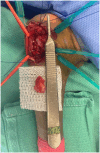Medial humeral epicondylitis: a retrospective case series of nine cats (17 elbows)
- PMID: 40735978
- PMCID: PMC12317204
- DOI: 10.1177/1098612X251347952
Medial humeral epicondylitis: a retrospective case series of nine cats (17 elbows)
Abstract
Case series summary The aim of this study was to describe the clinical findings, diagnostic results and response to both non-surgical and surgical therapy in cats with medial humeral epicondylitis (MHE). The medical records of one institution were searched for cats with a radiographically confirmed diagnosis of MHE where non-surgical therapy alone or both non-surgical and surgical therapy had been trialed. Nine cats (17 elbows) were included. None of the cats had a history of outdoor access. Orthopedic examination revealed pain upon palpation over the medial epicondyle (n = 15), elbow pronation/supination (n = 7) or carpal flexion (n = 7) and palpable mineralization distal to the medial epicondyle (n = 7). Epicondylitis was radiographically graded as mild (n = 8), moderate (n = 7) or severe (n = 2). CT was performed in 10 elbows and revealed additional information in seven, including intra-articular mineralized bodies in five elbows. Ultrasound was performed in four elbows and revealed fluid surrounding the flexor carpi ulnaris muscle. After non-surgical management, four cats showed no response, four showed a partial response and one showed a complete response. Cats with less advanced radiographic changes appeared to show more favorable responses. Four cats (seven elbows) underwent surgical treatment with ulnar neuritis being evident in all. Lameness resolved postoperatively in three cats (five elbows).Relevance and novel information An insidious onset of moderate-grade lameness associated with pain on palpation caudodistal to the medial epicondyle should increase the index of suspicion for MHE and prompt assessment for the presence of palpable mineralization and pain on carpal flexion. Ulnar neuritis is common in cats with MHE and they frequently present with free articular mineralized bodies. Radiographs can only detect advanced or chronic stages of MHE, by which time non-surgical management is likely to be ineffective. Earlier diagnosis using ultrasound may improve the prognosis after non-surgical management.
Keywords: Medial humeral epicondylitis; elbow; flexor carpi ulnaris muscle; lameness; mineralization.
Plain language summary
A description of the diagnosis and treatment of medial humeral epicondylitis, a condition similar to golfer’s elbow or little leaguer’s elbow in humans, in nine cats (17 elbows)Repetitive, prolonged activities involving wrist and forearm movement have long been associated with the onset of epicondylitis in humans. When this affects the lateral epicondyle, it is colloquially termed ‘tennis elbow’. When the medial epicondyle is involved, this is often referred to as ‘golfer’s elbow’ or ‘little leaguer’s elbow’. Medial humeral epicondylitis (MHE) is increasingly recognized as a cause of forelimb lameness in cats; however, information on this condition remains limited. The increased flexibility of the feline elbow and the importance of this during feline activities, such as climbing and catching prey, have been proposed as possible factors in the development of this condition in cats. MHE is a degenerative condition, the eventual result of which is the replacement of normal tendon tissue with scar tissue or mineralized tissue. This can also cause inflammation of the ulnar nerve, which travels in close proximity. Once the nerve is involved, non-surgical methods of treatment are less likely to be successful. This study adds information on 17 elbows in nine cats affected with MHE. Typical findings on orthopedic examination included a pain response on palpation over the medial epicondyle, a bony prominence on the inner aspect of the elbow. Pain was also evident during elbow range of motion, particularly with internal and external rotation, and occasionally during carpus (wrist) manipulation as well. In some cats, the mineralized portion of the tendon was palpable, which was often associated with pain. Although this condition has historically always been diagnosed using radiographs, the use of CT was shown to be advantageous as it frequently demonstrated the presence of mineralization within the elbow joint, which was not appreciated radiographically. In addition, the use of ultrasound showed promise in facilitating an earlier diagnosis, which may render non-surgical management more efficacious.
Conflict of interest statement
Conflict of interestThe authors declared no potential conflicts of interest with respect to the research, authorship, and/or publication of this article.
Figures





References
-
- Streubel R, Geyer H, Montavon PM. Medial humeral epicondylitis in cats. Vet Surg 2012; 41: 795–802. - PubMed
-
- Streubel R, Bilzer T, Grest P, et al. Medial humeral epicondylitis in clinically affected cats. Vet Surg 2015; 44: 905–913. - PubMed
-
- Renier S, Negro L, Carli E, et al. Medial humeral epicondylitis in Maine Coon cats based on computed tomography findings: a cross-sectional study [abstract]. Vet Surg 2024: 53: O49. DOI: 10.1111/vsu.14127.
-
- Perry KL. The lame cat: common culprits of non-traumatic lameness when pain localises to the elbow or shoulder. Companion Animal 2015; 20: 86–91.
MeSH terms
LinkOut - more resources
Full Text Sources
Medical
Miscellaneous

